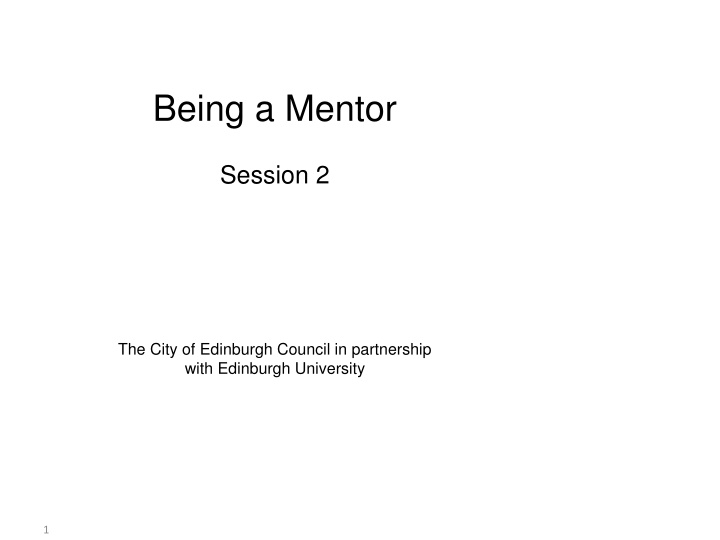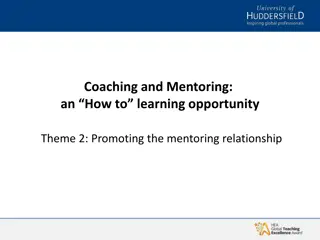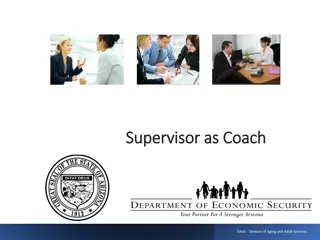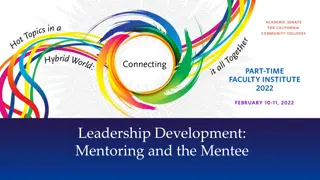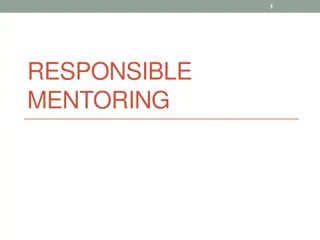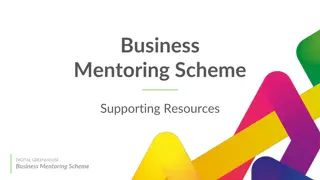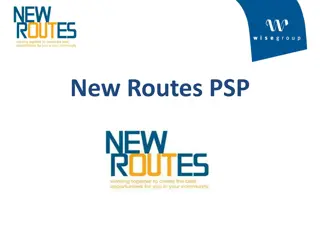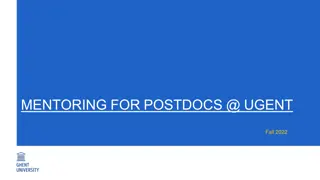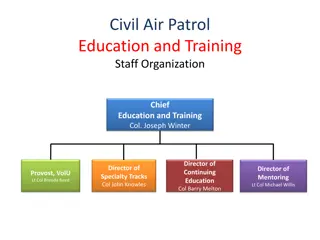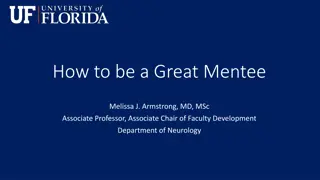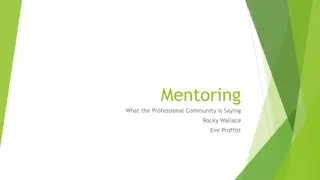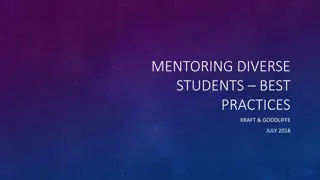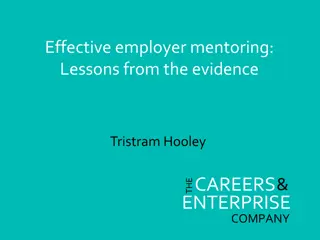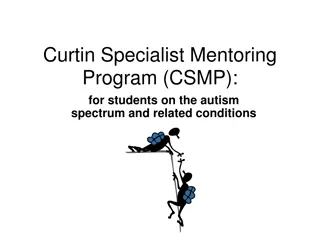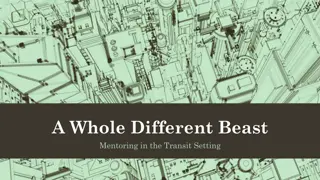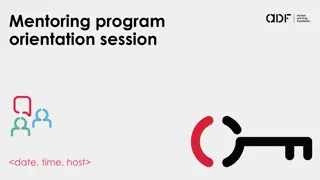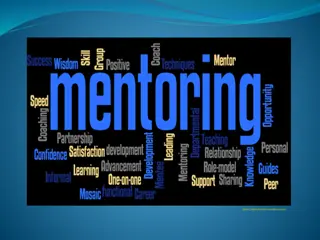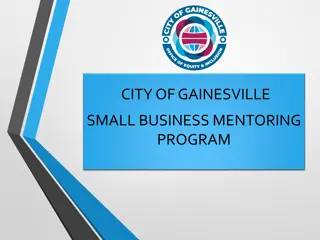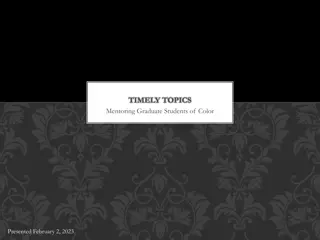Insights on Mentoring and Communication Strategies
Explore the roles of a teacher mentor, the mentoring continuum, stages for effective dialogue, and strategies for a mentoring dialogue. Discover tips for getting started, wisdom on overcoming fear in learning, and the importance of understanding before seeking to be understood in communication. Dive into the nuances of communication - words, tone, and facial expressions.
Download Presentation

Please find below an Image/Link to download the presentation.
The content on the website is provided AS IS for your information and personal use only. It may not be sold, licensed, or shared on other websites without obtaining consent from the author.If you encounter any issues during the download, it is possible that the publisher has removed the file from their server.
You are allowed to download the files provided on this website for personal or commercial use, subject to the condition that they are used lawfully. All files are the property of their respective owners.
The content on the website is provided AS IS for your information and personal use only. It may not be sold, licensed, or shared on other websites without obtaining consent from the author.
E N D
Presentation Transcript
Being a Mentor Session 2 The City of Edinburgh Council in partnership with Edinburgh University 1
Teacher Mentor Roles Problem solver Resource Advocate Teacher Facilitator Trusted Listener Coach Collaborator Assessor Ref: New Teacher Center, Santa Cruz, Learner California (2007) 2
The Mentoring Continuum Collaborative Instructive Facilitative Ref: New Teacher Center, Santa Cruz, California (2007)
The Four Stages for Dialogue Before (1) Planning and Preparation During (2) Facilitating the conversation (3) Agreeing the outcome/action/next steps After (4) Evaluating / Feedback/Review
A Mentoring Dialogue...reminder Assess the mentee s needs by: Building trust Identifying successes and areas for development Establish a focus for work by: Paraphrasing Clarifying Support mentee s development by: Instruction Collaboration Reflection Promote accountability by: Identifying next steps Follow-up Ref: New Teacher Center, Santa Cruz, California (2007) 5
Getting to know you Getting started... What are the benefits, the challenges, the strategies, which might support the process ? Key Question How are we going to work together? Share your ideas in a small group 6
Wise words Remember that any time you want someone s brain to do something new it is likely to bring up fear and concern, stopping their neurons from processing new ideas. So it is important to make people feel safe. Ref: Rock, David (2007) Quiet Leadership; Harper Collins, New York 7
Seek first to understand, and then to be understood.. - Stephen R. Covey Ref: Covey, Stephen R. (2004) The 7 Habits of Highly Effective People Simon and Schuster Pub New York
What goes into our communication? Words Tone Facial expression
Listening Levels 3 Level 3 - Attentive, person-focused ..interesting way of looking at things, I d like to know more 2 Level 2 listening in part, and adding your own meaning/advice I know, I ve done that too, and here s what you should do about it.. Level 1 Waiting to say your stuff I have something far more interesting to say.. 1
The Mentoring Conversation Setting the tone Opening up the opportunity for self evaluation and reflection Identify goal(s) Explore current position Consider options Commit to action/next steps
Goal / Plan / Actions Begin with the end in mind..... Long term goals Short term goals 12
Stimulus for Dialogue Teaching and Learning experiences Outcomes for learners Area of GTCS Standard Successes Challenges Next Steps 13
TALK Tell the person what you are thinking from the start Illustrate your assumptions about the situation with examples that you have directly observed or heard that led to your conclusions. Ask whether he/she has the same interpretation of the situation. If not, ask that the person explain his/her alternative view of the situation. Listen to his/her response Listening refers to stating what was understood, checking to see if this is what was meant, exploring differences, and working to reach consensus on a joint meaning of the situation Keep open to others views For dialogue to be productive all parties must acknowledge that theirs is only one interpretation of a situation; shared meaning can only come from accepting and surfacing our multiple understandings. Ref: O Neil, J and Marsick, V;(2007) Understanding Action Learning ; Amacom Pub 14
Mentoring in Practice A Caf Conversation In small groups read the scenario. 1. 2. What assumptions might you make? 3. How can you test your assumptions? 4. What additional information might you need? 5. How might you introduce the discussion/what questions might you need to ask? 6. What support might you provide? 7. Is there anything additional that you might need to consider? 15
Ref: New Teacher Center, Santa Cruz, Career waves California (2007) Anticipation Anticipation + Reflection Survival Rejuvenation Disillusionment _ 16
Mentoring in Practice Group Discussion Consider what the mentee needs at each phase Suggest strategies which might be useful during this phase 17
Tools to Support the Process Reflective Log Goal Setting Tool Evidence of Development 18
Tools to Support the Dialogue Coaching Model GROW Reflective Questions Consequence Matrix Metaphors 19
Mentoring Competencies Reflecting Maintain and review the process, relationship, progress and achievements Record and maintain notes Reflect on and develop own mentoring competence Ref: New Teacher Center, Santa Cruz, California (2007) 20
References New Teacher Center, Santa Cruz, California http://www.newteachercenter.org/ Megginson, D. and Clutterbuck, D., (2009) Further Techniques for Coaching and Mentoring; Butterworth Heinemann Rock, D.,(2007) Quiet Leadership; Harper Collins, New York (2007) O Neil, Judy and Marsick, Victoria (2007) Understanding Action Learning ; Amacom Pub Covey, Stephen R. (2004):The 7 Habits of Highly Effective People; Simon and Schuster Pub New York 21
